This website is supported by its readers. If you click one of my links I may earn a commission. I am also a participant in the Amazon affiliates program and I will also earn a commission from qualified purchases.
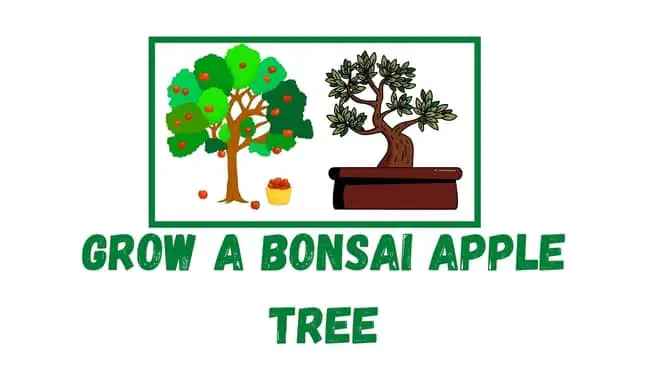
It’s estimated that there are 7500 varieties of Apple trees globally with around 2500 of these varieties being grown directly in the USA. With bonsai becoming incredibly popular, that leaves a lot of room for crossover. So is it possible to grow a bonsai Apple tree?
It is possible to grow an Apple tree as a bonsai tree. To do so, plant your seed or cuttings in a small pot. As new growth emerges, move into a bright warm spot. Water daily, maintain its temperature and train effectively. After a few years, your Apple tree bonsai will be complete.
Crab Apple bonsai trees also make for good apple bonsai trees.
So what is the exact step-by-step process of growing an Apple tree bonsai? And do Apple tree bonsai produce edible fruit? Keep reading to find out more!
Just a quick heads up, over the past three years of running Plantpaladin, hundreds of people have asked for product recommendations. As such, You can find my favorite indoor bonsai tree here (link takes you to Bonsaiboy), my favorite outdoor bonsai tree (link takes you to Bonsaiboy), or have a look at all the products I recommend here.
Grow a bonsai Apple tree
Bonsai tree keeping can often be seen as an exclusive activity to get involved with, needing to buy expensive plant species and equipment just to get started.
One species then that nips all of these concerns in the bud are Apple tree bonsai which are widely available, relatively inexpensive, and not too difficult to manage.
I recently just started growing an Apple tree bonsai myself and so I scoured the web, got in touch with a few bonsai experts, and even undertook a quick survey of 10 plant paladin readers to find out exactly how to grow a bonsai Apple tree.
To summarise:
- Apple trees and all Apple tree species can successfully be grown into bonsai trees.
- As Apple trees are available globally they can be grown in most locations.
- That being said Apple bonsai often prefer warmer, sunnier climates so are best suited to outdoor conditions.
- Growing can either be done via seed or cuttings.
- Apple bonsai does however require a lot of water so ensure you water at least once daily and check daily for dry topsoil. Avoid overwatering however which can cause things like root rot.
Grow a bonsai Apple tree – Quick facts
Apple bonsai tree requirements | Explained |
Water | Water once per day in the spring, only if the soil is dry to touch, During the summer and hot conditions watering several times a day may be required. Use moisture trays or place your pot in a bowl of shallow water to prevent it from drying out. Water once per week in winter as a rule of thumb. More watering is required when fruiting. |
Sunlight | Direct sunlight for 6 hours per day during the spring and summer. Place in the shade/semi-shade during the brightest weeks of the year. |
Temperature | Between 40 degrees F and 90 degrees F. Although they can survive in warmer and cooler conditions for limited periods. If temperatures drop below, ensure the roots are protected by mulch |
Fertilizer | Fertilize with organic fertilizer once every 6 weeks. Liquid fertilizer can also be used, however, aim for lower nitrogen levels which will cause the tree to grow as opposed to the fruit. |
Repotting | Once per year in the spring. |
Placement | Outdoors only |
Species Type | Deciduous |
Wire type | Both copper and aluminum |
Time to grow from seed | 5 years |
Potting Soil | Inorganic mix of akadama and volcanic ash rock. Organic soil such as peat soil can also be used. |
Growth type | Fast-growing, adding 12-36 inches of growth per year when young. This then slows down after 5 years or so to a medium-growing bonsai. |
Size | Medium to large, most trees sold is typically two hand bonsai. |
Lifespan | 50 to 100 years if used for bonsai (30 to 50 years if not used for bonsai) |
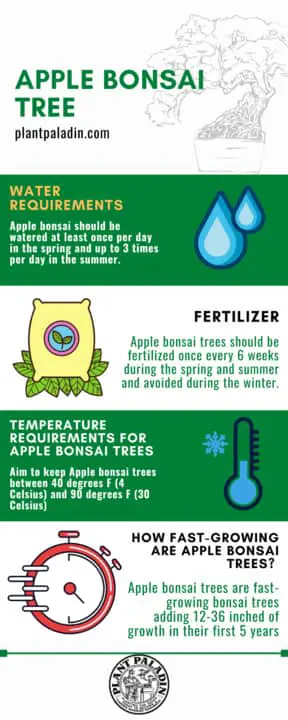
How to grow a bonsai Apple tree
So now you know the quick facts about growing a bonsai Apple tree, what is the exact step-by-step process of growing a bonsai Apple tree?
Let’s explore these in the next steps:
Decide on your Apple tree species
So before you do anything else, the first decision you need to make is what Apple tree species you will grow.
If you already have an existing Apple tree in your backyard and want to use the cuttings then you can go ahead.
If however, you want a specific color of apple or a specific tasting Apple, then you may need to purchase a new tree or seeds.
A few questions you should ask yourself before deciding on what bonsai Apple tree you want to grow is:
- How much time do you have to spend on bonsai – if you have more time then a faster-growing species may prove more beneficial
- Do you want your bonsai to be aesthetic only? Or to have nice tasting Apples?
- Will you prefer if your tree is kept indoors or outdoors?
- Do you want an Apple bonsai tree that is native to where you live and your geography and climate? Or do you want to export a different variety?
- How much experience do you have in growing fruiting bonsai?
If you live in a warmer climate in the summer with plenty of sunlight then I would recommend growing something like a Red Falstaff Apple.
If you tend to have a wetter, colder climate in the summer then something like a Red Windsor will work well.
Should your climate be just cold and wet year-round, sadly, this is not the best climate for growing Apple tree bonsai although Crab Apple bonsai can still be grown in these conditions.
Ensure it’s the right time of year
Once you know what species of Apple tree you will transform into bonsai you can start moving on to the growing process.
One thing however all too many beginners forget when growing bonsai trees is failing to ensure the right time of year.
For most mild conditions planting an Apple tree bonsai in the early spring is the best.
This will allow your Apple tree bonsai to grow out as the temperatures begin to grow and make the most of the bonsai growing season.
If however, you live in a warmer climate such as Southern States in the USA then you can also plant your Apple bonsai in the fall, although you need to ensure that temperatures do not fall below zero.
As a rule of thumb then plant your Apple tree bonsai in the early spring.
What if I grow my Apple bonsai from a seed?
The above however only counts if you are growing your tree from a cutting or a store-bought tree.
If you are growing your Apple tree bonsai from seed, you need to plant this in the fall, so the tree goes through a dormancy stage before it will start to grow in the spring.
When should I buy my Apple tree?
If you are buying a store-bought Apple tree, you might think it is fine to purchase it at any time of year.
Not true.
Apple trees regardless of species, grow on a yearly harvest, and so the best time to purchase an Apple tree is in the summer when the most sizes and varieties are widely available.
This should be done even if you do not plant your Apple tree bonsai until the next spring.
Decide on the style of your Apple tree bonsai
Another thing that all too many people forget is coming up with a plan for the design of their Apple tree bonsai.
You see whilst it will take a few years before your tree starts to resemble a bonsai, not having an idea of how you want your tree to look will make it more difficult to achieve a good-looking bonsai tree.
As such, first, decide on the style of bonsai tree you want.
Bonsai trees come in a wide variety of styles such as cascade, semi-cascade, informal upright, and Sumo.
Make a quick drawing then, of your Apple tree bonsai on a piece of paper.
Then simply work backward and figure out where the branches need to be moved too, how many branches you want
Keep in mind you don’t necessarily have to stick to your design, but doing this when you start growing your tree from scratch will give you something to aim for, making the process of growing a lot easier.
What about the size of my bonsai Apple tree
This is also a good opportunity to look into how big you would like your Apple tree bonsai to grow.
Apple tree bonsai tend to grow relatively fast in their first few years (between 12 and 36 inches).
This then slows down a little after 5 years to between 8 and 15 inches per year – which is still pretty large.
As such, having an idea of how large you want your tree to grow and the size classification you want your tree to fall under will be important if you do ever decide to enter things like bonsai exhibitions or competitions.
Decide on growing your Apple bonsai from seeds or cuttings
Now we can move on to the actual planting of your bonsai Apple tree.
The first step then is deciding on if you will grow from a cutting or grow from seed.
Typically growing from seed will usually be more complicated due to seeds not propagating correctly and additional steps required when compared to cuttings.
That being said, with Apple trees being so widely available and Apple trees growing relatively fast, the differences between growing via seed and cutting are not that big.
What is growing an Apple tree bonsai from a seed
This is simply the process of growing an Apple tree bonsai from scratch using a seed in a pot and growing the tree
Seeds are either bought from a store or taken from an existing Apple tree.
What is growing an Apple tree bonsai from a cutting
Growing an Apple tree bonsai from a cutting is the process of removing a branch from an existing Apple tree and using that as a way to propagate a new Apple tree.
This process will clone your original tree.
The cutting that you take does not need to be from another Apple bonsai tree, but can simply be from another Apple tree.
Advantages of using Apple seeds to grow bonsai
The main advantages of using Apple seeds to grow bonsai trees include:
- A much larger variety of Apple tree species you can choose from
- You can get Apple trees that are not available in your location
- Relatively inexpensive with Apple seeds being notoriously cheap to purchase
Disadvantages of using Apple seeds to grow bonsai
The main disadvantages of using Apple seeds to grow bonsai are:
- Seeds will require some scarification or stratification to get ready if planting outside of the fall.
- Seeds will take longer to grow than cuttings
- Some seeds will fail to propagate having a higher failure rate than growing from cuttings
- Pests such as squirrels or birds are more likely to dig up your seeds than they would cuttings.
- Different fruit – if growing from seeds, the likelihood of growing and getting the same variety of fruit will be limited. This is because, unlike cuttings which are a direct clone, as the Appletree gets fertilized, it may get fertilized by another Apple species meaning the likelihood of say getting Gala Apples from a seed taken from a Gala Apple tree will be limited.
Advantages of using Apple tree cuttings to grow bonsai
The main advantages of using cuttings to grow bonsai trees include:
- Using cuttings will grow your bonsai faster than if you would use seeds
- They are less likely to be attacked by birds and other pests due to their larger size
- Easier to visualize, making it easy to grow out better-looking bonsai trees
Disadvantages of using Apple tree cuttings to grow bonsai
The main disadvantages of using cuttings to grow bonsai trees include:
- Repotted more often – These trees grow fast and will need to be repotted more.
- Less variety – Most cuttings will be taken from local species meaning the variety in your species will not be as high when compared to using seeds.
My recommendation
Whilst both seeds and cuttings can be used to grow Apple bonsai trees, my recommendation has to still be using cuttings.
This will save you a lot of time in the growing process and just make it a lot easier to grow your Apple bonsai tree.
Growing an Apple bonsai tree from a seed
So whilst I feel as though growing an Apple bonsai tree from a cutting is the best option, I want to ensure that this post is the most complete post around growing an Apple bonsai tree.
As such, let’s dive into the exact step-by-step process of growing an Apple bonsai tree from a seed.
Purchase your seeds
First up, purchase your seeds.
There are 3 main methods from which you can do this:
- Buying online
- Buying from a local retailer
- Using your own seeds
Buying from a local retailer will likely be the best option as these seeds will already have been acclimatized to your location.
Buying your seeds online will allow you to have a much wider variety of Apple tree species.
You will however need to double-check and ensure that the counties these seeds are from are compatible with your climate.
Finally, you can also pick the seeds yourself.
This is my preferred method.
To do so, carefully cut open a ripe Apple – I find using organic Apples tends to work best.
Then keep the seeds dry for 2-3 days in a space that is not too hot not too cold, not too wet, or not too dry.
If it is the fall, you can then plant directly into the potting soil.
This will give your seeds the necessary dormancy period in the winter for the seeds to mature before they start to grow.
If however, you are planting your seeds outside of the fall, then stratification will be required.
How many seeds should I plant?
As a rule of thumb, if you want to grow three Apple bonsai, I would aim to plant between 15 and 20 seeds.
Not all the seeds you have will propagate correctly and so you will have much better odds planting more seeds than you think you will need.
Stratify your seeds
If you are growing your seeds outside of the fall, or want to bypass the dormancy period that Apple seeds need before they grow, then stratification of your seeds will help bypass this process.
To do this, get a plastic box, or clear plastic ziplock bag.
Place either a paper towel or a moss of some kind, (I found that sphagnum moss works well for this) at the bottom of your box or bag.
Then gently place the seeds inside.
Place this inside a refrigerator or cold space ( temperature of around 40 degrees works well for this)
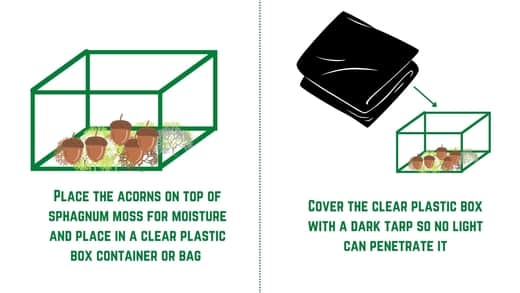
Now as all Apple tree species seeds are different, the seeds will propagate at different times.
As such, after about 2-3 weeks you should check your seeds every few days to see signs of propagation and a taproot starting to sprout from the seeds.
Every few days remember to spray your paper towels or moss with water to ensure a consistent moisture level.
Plant your seeds
Once the taproot starts to form on your seeds you can plant them directly in the soil.
To do so, first find the right pot.
At this stage, it is not necessary to use a shallow or expensive bonsai pot.
Instead, using something like a yogurt pot that is about 4 inches high I find works well.
Ensure however that you drill a few holes at the bottom of your yogurt pot to help with drainage and moisture flow.
Then fill with a soil mix.
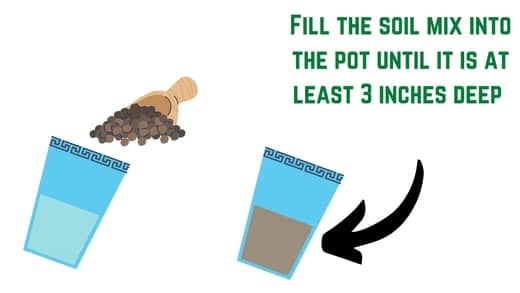
We will cover the best potting soil for Apple bonsai a little later in the post but as a rule of thumb, using either an organic mix of peat soil with some volcanic grit or akadama in a 30/30/30 split will work best.
Fill up your pot then about halfway full.
Make an indentation with your finger and plant your seed.
Then cover the seed in the remaining soil.
Once completed maintain good aftercare by watering regularly at least once every few days.
Keep in a propagator for a few weeks
Whilst you can move your seeds directly outdoors, at this stage I like to keep them in a propagator for a few weeks.
Doing so will give you complete control of temperature, moisture levels, and a whole host of other elements that will be critical to your Apple seeds growing healthily.
Aim to keep them in a propagator then for a few weeks.
This will also prevent pests such as birds and squirrels from digging up your seeds right away.
I like to keep my seeds in a propagator for about 4 weeks, just until the green shoots start to apeak through the topsoil.
Move your Apple bonsai into position
Finally, move your Apple bonsai into position.
Apple bonsai like to be grown in bright sunny conditions, but moving the seeds into this environment right away will be a shock to the tree.
Instead, ease the tree into the shade for a week.
The into the partial shade for another week.
Finally, you can then move your Apple bonsai into direct sunlight into its final location.
Maintain your tree
Over the next year, the only thing you should worry about is growing your tree and getting it as strong as possible.
To do this, ensure you provide your tree with around 6 hours of direct sunlight per day.
Aim to keep this in warmer conditions, ensure you touch the topsoil daily.
If dry to touch then water your tree.
Also keep a vigilant eye on pests and insects that love Apple trees such as Aphids, using a pesticide, or even natural predators to prevent these from attacking your tree.
After your first year, you can then move on to repotting your Apple tree bonsai.
The only caveat to this would be fertilizing which I like to avoid in the first year of a new bonsai tree’s growth if growing from seed.
Growing an Apple bonsai tree from a cutting
Now alternatively, if you would like to grow your bonsai tree from a cutting instead of growing from scratch or seed then I would do the following:
Make a cutting at a 45-degree angle
First up, get the existing Apple tree that you will be making a cutting from ready.
If the Apple tree you will be making the cutting from does not produce fruit, then the cutting you take will not produce fruit so ensure you have a high-quality tree first.
Then, using a pair of shears or other bonsai accessories, make one sharp cut on the branch of your tree near the trunk of the tree.
This should be undertaken at a 45-degree angle.
Now it’s important that the cutting is only taken when the buds first start to appear on the Apple tree.
This will ensure that these cuttings will be able to grow into successful trees.
You can then remove any excess leaves on the branches – just be sure to not cut off the bud.
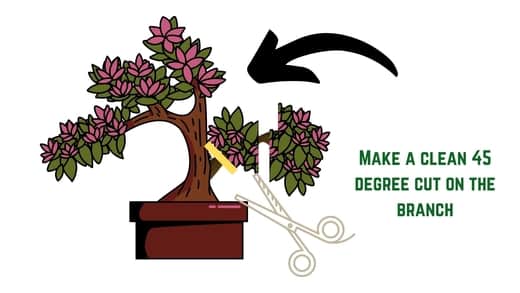
How long should the cutting be?
For best results, aim for the cutting to be between 4 and 8 inches long and about the thickness of a pen or pencil.
Growing with large cuttings is also possible although root hormone may be required.
Remove the cambium
Next up, you need to prepare the cuttings.
To do this, use a scalpel, knife, or other sharp object and score around the bottom 1 cm of the cutting.
Then using pliers peel back the cambium of the cutting until the white inner wood is on show.
This will make it easier for the Apple tree to spout new roots.
Unlike using larger cuttings, root hormone or rooting powder will not be needed as Apple species are quite easy to propagate.

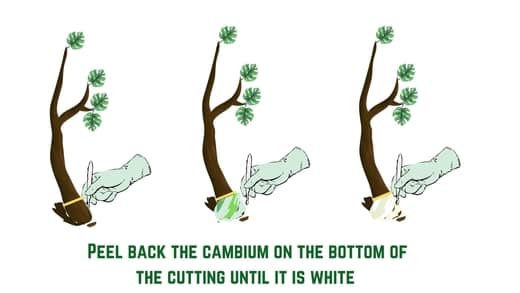
Place in water
Now your cuttings are prepared, fill up a mason jar or cut the top off a bottle, fill with regular tap water (although rainwater also works well) until it is about half full and place your cutting in the water.
The cutting will need to be placed here for a few weeks/months until the new roots start to form on the bottom of the cuttings.
During this time, due to evaporation, the water level will reduce.
If so, just top up with new water and check in every few days to measure the water level.
Ideally, place the jar in a cool dry space that gets plenty of sunlight – a garage then with a window works well for this.
Plant in a pot
Once the cutting has formed roots in the jar, it is time to move them into a pot.
As you will be repotting the bonsai in one year, using a yogurt pot again will work best for this,
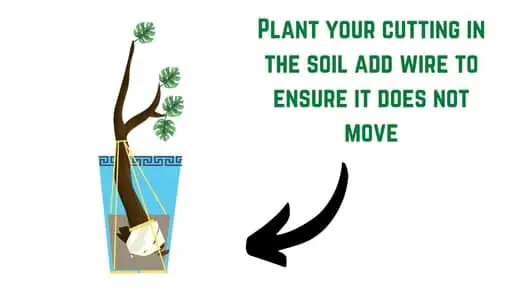
In this instance, however, you might need to opt for a larger pot.
Alternately, using a clear see-through pot can also work so you can track the progress of the root growth.
Drill a hole in the bottom of your pot and thread through a wire that will hold your cutting in place.
Then fill with the potting soil of your choice until about half full with a hole in the middle for your cutting.
Add your cutting ensuring the roots are facing downwards.
Tie this in place with the wire to ensure the cutting does not move.
Then refill the pot with the remaining potting soil.
Move into position
Finally, move your tree into position in a bright sunny spot in your garden. Ensure regular aftercare is then undertaken as mentioned early.
After a year or so you will need to report your Apple tree bonsai
Repot your bonsai Apple tree
So regardless of if you have planted your Apple tree bonsai via seed or cutting, the first year is all about as growing as strong and healthy an Apple tree bonsai as possible.
Near the end of the first year, however, you will need to repot your bonsai Apple tree.
Now, this is often a complex process but to summarize how to do this:
Select the right size pot
At this stage, you can start making choices about the style of your pot and so I would recommend using a shallow bonsai pot as your tree will have sufficient growth.
Ensure then that your pot will have enough drainage holes: the table below should help to depend on the size your Apple bonsai has grown to in its first year:
Size Classification | Size inches | Number of penny-sized holes | Number of pencil-sized holes |
Keshitsubo | 1 to 3 inches | 1-2 | 0 |
Shito | 2 to 4 inches | 1-2 | 0 |
Mame | 2 to 6 inches | 2 | 2 |
Chohin | 5 to 8 inches | 2 | 2 |
Kumono | 6 to 10 inches | 2 | 2 |
Katade-mochi | 10 to 18 inches | 2 | 3 |
Chiu or Chumono | 16 to 36 inches | 2 | 4 |
Dai or Omono | 30 to 48 inches | 3 | 6 |
Hachi-uye | 40 to 60 inches | 4 | 8 |
Imperial | 60 to 80 inches | 6 | 8 |
Remove the excess soil and roots
Next up, use a root hook to go around the soil of the pot your bonsai is currently in.
This should loosen the tree.
Then gently lift the tree up from its pot.
Reduce the larger clumps of soil using a root hook and trim down some of the roots by about 50% using shears.
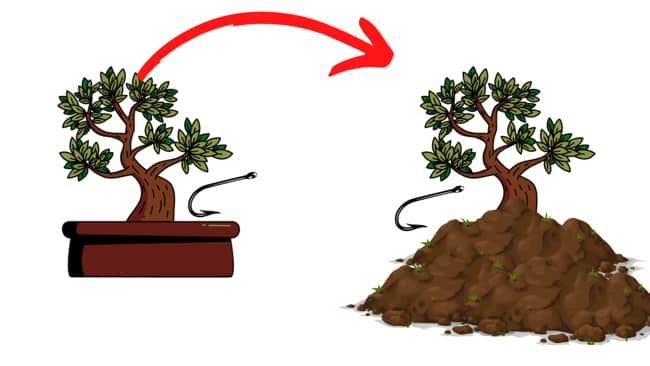
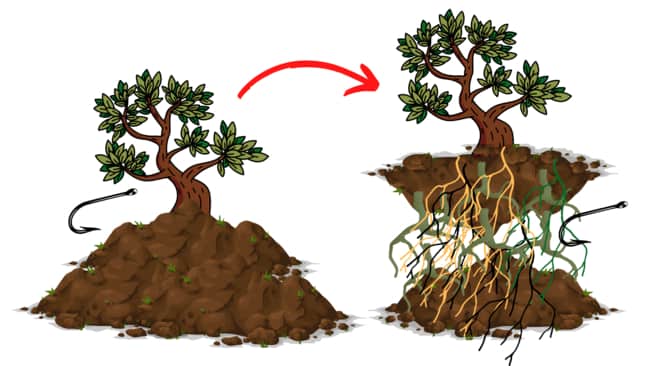
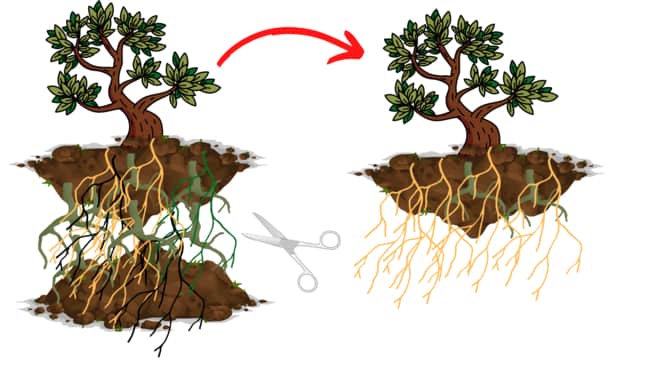
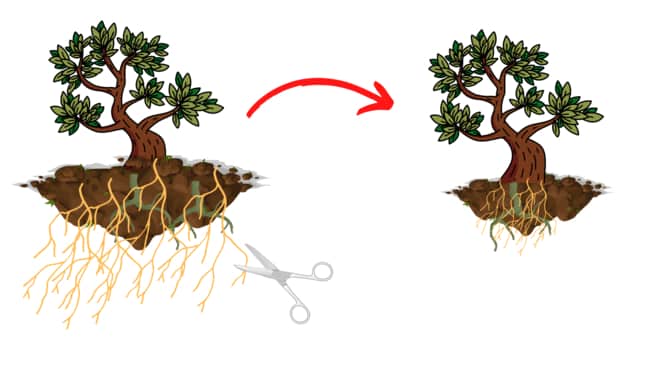
Prepare the drainage holes
In your new bonsai pot, apply a wire mesh to the bottom holes, this should ensure that your soil does not dry out and hold on to enough moisture.
You can do this by looping the copper wire through the mesh and tying it in place.
Then loop through two longer strands of copper wire in the holes.
Thighs will be sued to hold your tree in place.
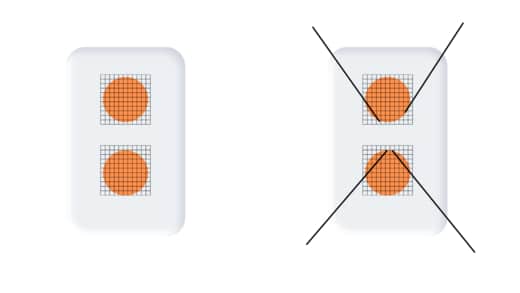
Add soil
Next up, add the potting soil of choice to the tree, ensure you start with a base layer.
Make sure there is a dip in the soil in the center of the pot where you can place your tree.
Place your Apple bonsai tree
Finally, place your Apple bonsai in the center of the pot, with the most aesthetically pleasing angle facing forward.
Cover the remaining pot with the topsoil.
Finish by wrapping the copper wire around the tree to hold it in place for a few weeks as the tree acclimatizes to its new location.
Once completed, follow adequate bonsai repotting aftercare.
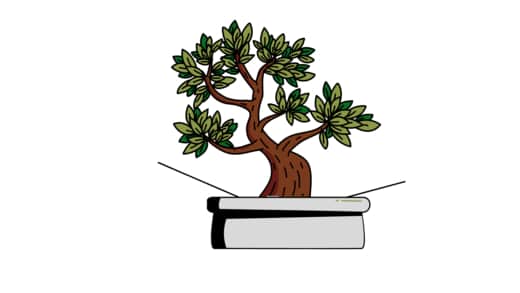
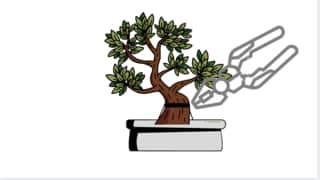
Train your Apple bonsai tree
So you’ve grown your Apple bonsai tree from a seed or cutting and have successfully repotted it.
So why does your Apple tree not look like a bonsai tree
Well in order to get the right bonsai look, a few years of training will now need to be undertaken to get your Apple bonsai to look like a bonsai tree.
This is mainly undertaken in three main ways:
- Trunk development
- Wiring
- General pruning
Let’s explore these in more detail
Develop the trunk of your bonsai Apple tree
Apple bonsai trunk development is a very complex process.
The aim of this is to add taper, thickness, and shape to the trunk – specific for the style of tree you are going for.
For example, if you are creating a cascade bonsai tree, then the trunk of your tree needs to have a gentle taper as well as a crescent shape to it.
The main ways you can develop the trunk of your Apple bonsai tree then is by:
- Growing a sacrifice branch – This is the process of growing out a branch without trimming it for a few years. This will add significant width to the trunk of your Apple bonsai.
- Trunk chopping – Removing the top half of the trunk of your tree will force your tree to grow a taper which is ideal for bonsai styles that have a wide bottom trunk and a thin top trunk such as sumo.
- Trunk bend – To add bends in the trunk of your tree, for styles like a cascade or informal upright, remove chinks of the trunk and then force them closed to add movement to the trunk.
This process will take a few years on most bonsai species.
Wire your Apple tree bonsai
Once your trunk has been developed you will then have a solid base to work from.
The next step then will be to wire your bonsai branches, moving them into position and giving the complete and proper look of an Apple tree bonsai.
What is the best wire for Apple bonsai trees?
Both annealed copper and anodized aluminum wire can be used to wire an Apple bonsai. This is because Apple bonsai are hardy and have thicker branches and trunks that can take a lot of damage. Raffia too can be used to help the wiring process.
To wire an Apple bonsai tree then:
Cut your wire to size
Aim for the wire you select to be about 1/3rd the size of the thickness of the branch you will be wiring.
To test if the wire you have selected is thick enough, push it against the branch.
If the branch pushes the wire more than the wire pushes the branch then you need a thicker wire.
The wire should also be about 30% longer than the length of the branch if using the single wiring technique and 50% longer than multiple branches if following double wiring.

Wrap your wire around the trunk of your tree
Aim for this to be undertaken at a 45-degree angle.
A good rule of thumb will be to wrap this around 2 or 3 times for a good anchor point.

Double and single wire your Apple bonsai branches
It is now time to wire your branches.
This falls into two main categories; double wiring and single wring.
Single-wiring is the most common type of wiring – you will simply use one wire to wrap one branch at a 45-degree angle.



This method is also used for the smaller secondary and tertiary branches with smaller wires.
Double wiring is undertaken on two branches that are nearby each other.



Double wiring can be more effective at leveraging other branches to move heavier, sturdier branches.
Move the branches into position
Once wired, simply move the branches into the position you would like them to move in.
Branches typically can be moved up or down or clockwise and anticlockwise.
If you fear your Apple branch might break, use raffia as a substitute to help lubricate the branch.
Remove the wire after a month
After a month, the will branch will have moved into their new potion.
Use a pair of shears to cut the wire.
Avoid using your hand to unfurl the wire which can damage the bark of the tree.
Prune your Apple bonsai
Finally, you will need to prune your Apple bonsai tree regularly to ensure it maintains good shape and style.
The best way to do this is to remove any excess leaves that might take away from the silhouette of the tree.
You can also use this time to add things like Jin, deadwood, and trunk splitting to your tree or even use brushes to help clean your tree.
Use regular pruning to defoliate your tree to add a more dense bonsai canopy.
Repeat the process
So the steps above are what I would follow in the first 3 to 5 years of your Apple bonsai trees life.
That being said, you will have to repot your tree once per year and repeat the process for at least another 5 years until you have a bonsai tree you will be truly happy with.
I’d also recommend ensuring you have correct aftercare for your Apple bonsai tree too.
Ensuring then that you water regularly, provide enough sunlight, fertilizer, and check for signs of fungal or pest infestation will be required weekly to protect the health of your apple bonsai tree.
Grow a bonsai Apple tree FAQs
So now you know how to grow a bonsai Apple tree, there are likely some other FAQs you will have around growing Apple bonsai trees.
As such, I’ve taken the time to answer some of these quick questions below:
How often should you water an Apple bonsai tree?
Apple bonsai should be watered at least once per day in the spring and up to 3 times per day in the summer. Apple bonsai trees will require a lot more water in the growing season than in the fall and winter. If your topsoil is dry to touch then your Apple bonsai needs watering immediately.
You should aim to ensure the topsoil of your Apple bonsai tree stays moist. In the winter, watering can be reduced to once per week.
What should I water my Apple bonsai tree with?
Using a watering can or hose will be adequate to water your Apple bonsai tree with.
Ensure that the water you use is natural.
Whilst general tap water can be used, excessive use will cause a lot of fluoride to build up in the soil causing a change in the PH level.
As such consider using rainwater as an alternative to water your Apple bonsai tree with.
Sunlight requirements for Apple bonsai
Apple bonsai require 6 hours of direct sunlight per day in the spring/summer growing season. During warmer conditions, Apple bonsai can be placed in the shade to prevent the tree from burning.
In the winter, leave these trees outdoors unless the temperatures fall below 0 degrees Celsius for too long.
Avoid using grow lights to grow Apple bonsai mainly because Apple tree bonsai cannot be grown indoors.
Temperature requirements for Apple bonsai trees
Aim to keep Apple bonsai trees between 40 degrees F (4 Celsius) and 90 degrees F (30 Celsius). If temperatures drop below this, cover the top roots with mulch to prevent the roots from freezing. If temperatures exceed this, move into a shady spot.
Apple bonsai then can be successfully grown in USDA conditions 11+.
Thankfully however as Apple trees can be grown natively in pretty much every country, there are no real countries or locales that will not be able to grow Apple bonsai at some point during the year.
Fertilizer requirements for Apple bonsai tree?
Apple bonsai trees should be fertilized once every 6 weeks during the spring and summer and avoided during the winter. A balanced Fertilizer with an equal N-P-K ratio should be used. Liquid fertilizers can also be used.
The only caveat to this would be if you are using a fertilizer that has a higher nitrogen level.
This is because the excess nitrogen will cause the tree to grow as opposed to the fruit.
Left unchecked this can even lead to your Apple bonsai not producing any fruit.
Where to place Apple bonsai trees?
Apple bonsai trees should be placed outdoors in a bright spot for at least 6 hours per day. During hotter summers, where temperatures exceed 90 degrees Apple bonsai trees can be placed in the shade. Apple bonsai trees should not be placed indoors, even in winter.
What is the best potting soil for Apple bonsai trees?
Apple bonsai trees can grow in almost any soil mix, so long as it provides a lot of aeration and holds on to moisture well. Sandy soil mixes then work very well for Apple bonsai.
My personal mix that I like to use is the following:
An inorganic mix of 50% akadama, 25% volcanic ash rock, and 25% pumice. This gives the perfect balance of aeration, moisture retention, and drainage.
How long does it take to grow an Apple bonsai tree?
It will take 10 years to grow an Apple bonsai tree from a seed. Apple bonsai trees are relatively fast-growing and so will mature in 3 to 5 years. Once mature these trees can be transformed into aesthetically pleasing bonsai in another 5 years.
What pests attack Apple bonsai trees?
Apple bonsai trees are regularly attacked by aphids, scale, spider mites, mealybugs, and caterpillars. To remove either invest in parasitic wasps or use an insecticide to prevent these from attacking your tree.
Apple bonsai trees are also more likely to get attacked by fungal infections such as rust or mildew.
How fast-growing are Apple bonsai trees?
Apple bonsai trees are fast-growing bonsai trees adding 12-36 inched of growth in their first 5 years. After year 8 this growth will slow down to between 5 to 12 inches of growth per year.
Are Apple bonsai beginner friendly?
Whilst not difficult to grow, Apple bonsai trees are not beginner-friendly as they can only be kept outdoors and require a lot of water. Apple bonsai trees should be grown as a second or third bonsai tree, once you have mastered the basics.
How long does it take for fruit to start appearing on Apple bonsai?
Apples on Apple bonsai trees will typically start to appear around year 5, once your tree has grown into maturity. Apples will bloom in the fall, between September and November.
Grow A Bonsai Apple Tree – Study
Finally, I wanted to do ask a few experts about growing Apple bonsai trees.
First, I got in touch with one of the employees at Birmingham Botanical Gardens and asked them if this was possible:
“ Most Apple tree species can easily be turned into bonsai trees, crab Apple varieties of Apple trees tend to be the most popular”
I also undertook a quick survey of plant paladin readers asking them if they thought it was possible to grow a bonsai Apple tree.
Here were the results:
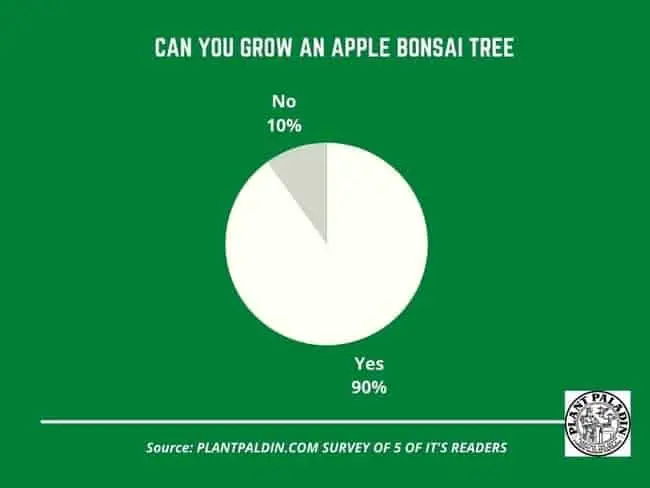
My top picks for the gear you will need!
So like I mentioned earlier, over the past three years of running PlantPaladin, hundreds of people have asked me for my recommendations on the best bonsai gear on the market.
Having spent thousands of dollars on bonsai items these past few years and tested at least 100 bonsai-specific products, I’ve listed my favorite products below – All of which I highly recommend and think you can get great value.
They can purchase directly by clicking the link to take them to Amazon.
Bonsai Tool Set: One of the significant challenges I’ve had is finding a toolset that was not only durable but didn’t break the bank. SOLIGT has recently developed a fantastic bonsai tool set that covers all the tools you need to trim, prune, and repot your trees. – You can grab it here.
Complete Bonsai Set: Many of you will want to grow your bonsai trees entirely from scratch, but finding the varicose seeds, pots, and other items in one place can be challenging. Leaves and Sole then have created a complete bonsai set that I’ve personally used that ticks all the boxes. You can grab it here.
Bonsai wire: The number of times I’ve run out of wire for my bonsai or purchased cheap bonsai wire that doesn’t do the job is embarrassing for me to admit. After a lot of trial and error, I found that using Hotop’s aluminum bonsai wire is one of the best options on the market. This can easily be used for both indoor and outdoor bonsai. You can grab it here.
This post was written by Fehed Nicass who has been passionate about bonsai for over 3 years.
